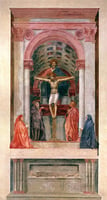Proto-Renaissance art is a term used to describe the art of the late Middle Ages and early...
Leading Art Academies: Europe's Creative Hubs

Explore the prestigious art academies in Europe that have shaped the world of art and continue to inspire generations of artists.
Preserving Cultural Heritage: The Role of European Art Academies
European art academies play a crucial role in preserving and promoting cultural heritage through their educational endeavors. With a strong emphasis on traditional techniques and historical context, these institutions serve as guardians of cultural legacy, ensuring that artistic traditions are passed down through generations.
By offering specialized courses in regional artistic styles, historical periods, and cultural movements, art academies contribute to the preservation of Europe's diverse cultural heritage. Students are not only taught how to create art but also encouraged to appreciate and understand the cultural significance behind each brushstroke.
Furthermore, many European art academies actively engage in research and restoration projects aimed at preserving historical artworks and monuments. Through partnerships with museums, cultural institutions, and heritage organizations, they contribute to the conservation of Europe's artistic treasures for future generations to enjoy.
In addition to preserving tangible heritage, art academies also play a vital role in safeguarding intangible cultural heritage, such as traditional craftsmanship techniques and artistic practices. By passing on these skills to future generations of artists, art academies ensure that cultural heritage remains alive and vibrant in the contemporary world.
Through their commitment to preserving cultural heritage, European art academies not only honor the past but also inspire future generations to continue the legacy of artistic excellence. By instilling a deep appreciation for cultural heritage in their students, these institutions contribute to the cultural richness and diversity of Europe as a whole.
Tracing the Historical Significance of European Art Academies
European art academies have long been revered as the heart and soul of creative education, embodying a perfect blend of tradition and innovation in the visual arts. From the golden age of the Renaissance to the present-day contemporary art scene, these esteemed institutions have played a pivotal role in nurturing the talents of budding artists and fostering a spirit of artistic exploration. More than just places of learning, these academies stand as cultural beacons that have witnessed and embraced some of the most groundbreaking art movements in history.
Each academy boasts a rich and storied history, intricately woven into the colorful tapestry of Europe's cultural heritage. Many of these institutions were established by royal decree or with the generous support of influential art patrons, underscoring their enduring commitment to excellence in the arts. The profound historical significance of these academies is palpable in the lasting legacy of their alumni, the masterpieces that have emerged from their studios, and their far-reaching impact on art education worldwide.
The legacy of European art academies extends far beyond their physical structures and curriculum. These institutions have served as crucibles of creativity, nurturing the talents of generations of artists who have gone on to shape the course of art history. From the groundbreaking innovations of the Renaissance masters to the avant-garde experiments of modern artists, the impact of these academies reverberates through the annals of art.
Moreover, the cultural significance of these academies cannot be overstated. They have been instrumental in preserving and promoting the rich tapestry of European artistic traditions, ensuring that the heritage of the past is carried forward into the future. Through their dedication to excellence, these academies have become guardians of Europe's cultural legacy, safeguarding it for future generations to cherish and draw inspiration from.
In essence, European art academies are not just educational institutions; they are living embodiments of the artistic spirit of Europe. They are sanctuaries where creativity flourishes, traditions are upheld, and innovation is celebrated. As we look to the future, it is clear that these academies will continue to play a vital role in shaping the artistic landscape of Europe and beyond, ensuring that the flame of creativity burns bright for generations to come.
Standout European Art Academies: A Tapestry of Tradition and Innovation
Europe boasts a diverse array of prestigious art academies, each with its own unique approach to art education that reflects the cultural heritage of its region. The Madrid Academy of Art in Spain stands out for its strong emphasis on classical techniques and its dedication to preserving and promoting Spanish artistic heritage. On the other hand, Italy's Florence Academy of Art is a shining example of Renaissance-inspired education, priding itself on a curriculum that follows the time-honored methods of the old masters, immersing students in the rich artistic traditions of the Italian Renaissance.
In Barcelona, the Academy of Art seamlessly blends traditional methodologies with contemporary practices, offering students a dynamic and vibrant environment that mirrors the region's thriving art scene. Moving to the UK, the London Fine Art Studios provide a comprehensive approach to art education, engaging students in a wide range of disciplines from painting to sculpture, fostering creativity and innovation. In Scotland, the Glasgow School of Art is renowned for its innovative programs and its significant contribution to the development of modern art, attracting students from around the world seeking a cutting-edge artistic education.
In Sweden, the Swedish Academy of Realist Art is highly esteemed for its unwavering dedication to realism and meticulous attention to detail, reflecting the Scandinavian approach to art education that values precision and craftsmanship. Each of these academies offers a unique experience, shaping the next generation of artists and contributing to the rich tapestry of European art education.
Curriculum and Specializations: Tailoring Your Artistic Journey
The curricula of European art academies are meticulously crafted to provide a comprehensive exploration of various artistic disciplines, allowing students to hone their skills and specialize in areas that resonate with their individual passions and professional goals. Whether students are drawn to the timeless art of painting, the intricate art of sculpture, the versatile world of printmaking, or the cutting-edge realm of digital media, these academies offer a solid foundation in the fundamentals before guiding students towards more specialized subjects.
The beauty of these academies lies in their ability to blend technical training with theoretical knowledge, offering students a well-rounded education that equips them for success in the art world. Students not only learn the technical skills needed to excel in their chosen medium but also delve deep into art history, theory, and critical thinking, enriching their artistic practice and expanding their creative horizons. This holistic approach to education ensures that students graduate with a broad understanding of the art world, ready to navigate its complexities and contribute meaningfully to its ever-evolving landscape.
From mastering classical art techniques passed down through centuries to exploring the latest digital tools and technologies, students have the opportunity to push the boundaries of their creativity and develop their own unique artistic voice. The flexible curriculum design allows students to tailor their education to their interests and goals, encouraging experimentation, innovation, and personal growth. By encouraging students to explore a diverse range of specializations, these academies nurture a spirit of curiosity and exploration, empowering students to create truly remarkable works of art that reflect their individuality and vision.
In this dynamic learning environment, students are not just taught how to create art but are also encouraged to think critically, engage with contemporary issues, and push the boundaries of artistic expression. By fostering a culture of creativity, collaboration, and open-mindedness, European art academies prepare students for the challenges and opportunities of the art world, equipping them with the skills, knowledge, and confidence to embark on successful and fulfilling careers as artists.
Networking and Opportunities: Beyond the Classroom Experience
Art academies in Europe are renowned for their commitment to providing students with a holistic education that extends beyond the confines of the classroom. In addition to honing their artistic skills, these institutions offer a plethora of networking opportunities that are vital for students to thrive in the competitive art world. By facilitating exhibitions, collaborations, and internships with esteemed galleries, museums, and professional artists, art academies open doors for budding artists to immerse themselves in the real-world dynamics of the art industry.
Through these invaluable experiences, students not only build meaningful connections but also acquire the practical knowledge and insights necessary to navigate the complexities of the art world. By showcasing their work in exhibitions, participating in collaborative projects, and interning with industry professionals, students gain firsthand exposure to the inner workings of the art world, preparing them for successful careers post-graduation.
Furthermore, the integration of workshops, guest lectures, and art fairs into the academy experience serves to enrich students' learning journey by providing them with a platform to engage with established artists and industry experts. These interactive sessions not only offer students the opportunity to receive valuable feedback on their work but also inspire them to push the boundaries of their creativity. By actively participating in these events, students not only enhance their practical skills but also cultivate a mindset of innovation and adaptability essential for thriving in the ever-evolving art landscape.
The dynamic and collaborative environment fostered by these networking opportunities not only nurtures creativity but also instills in students a sense of community and support. By fostering relationships with mentors, peers, and industry professionals, students are encouraged to explore new ideas, experiment with different techniques, and ultimately, carve out their own unique path in the art world. Through these interactions, students not only gain the necessary tools for success but also develop a sense of resilience and perseverance that are essential for navigating the challenges of a career in the arts.
Alumni Success Stories: From Students to World-Renowned Artists
These distinguished alumni not only serve as a testament to the enduring legacy of excellence at Europe's prestigious art academies but also embody the transformative power of art education. Their remarkable achievements reverberate throughout the art world, showcasing the profound impact of their education and mentorship on their artistic journeys. From winning prestigious awards to exhibiting their works in renowned galleries, these graduates have solidified their positions as influential figures who continually push the boundaries of creativity and redefine the standards of artistic excellence.
Moreover, beyond their individual successes, these alumni play a crucial role in shaping the future of the global art scene. Through their innovative approaches and profound artistic visions, they inspire and mentor the next generation of artists, imparting invaluable insights and expertise gained from their own experiences. By actively engaging in mentorship programs and returning to their alma maters to share their knowledge, these alumni create a supportive and nurturing environment that fosters creativity, collaboration, and growth within the artistic community.
As ambassadors of artistic excellence, these graduates not only showcase the caliber of education provided by European art academies but also contribute significantly to the vibrant and dynamic art landscape that captivates audiences worldwide. By championing creativity, breaking barriers, and fostering a spirit of collaboration, they embody the essence of artistic innovation and serve as beacons of inspiration for aspiring artists everywhere. Their ongoing impact ensures that the legacy of European art academies continues to thrive and evolve, shaping the future of art education and leaving an indelible mark on the art world for generations to come.




